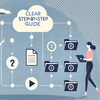![]()
It is exciting to see how technical writing is evolving and is being reshaped by the ever-changing world around us.
Social media was set on its mission to conquer the world in the 90s. This is when internet relay chats were developed and became available to the general public. First blogs appeared in the late 90s and blogging started gaining popularity quickly. But the true revolution happened in the mid-’00s with players like Facebook and Twitter entering the scene. And so it began.
Seems like social media has predefined the mindsets of the generations to come. It keeps influencing so many aspects of our lives, and technical communication is one of them. Let’s see what traits of help authoring were changed by the omnipresent social media.
Better Design of User Manuals

A couple of decades ago people didn’t really think too much about how user manuals looked. The main criterion was readability. So, most of technical documentation was more or less the same in terms of design.
Now, technical writers have to worry about documentation looking outdated. While people do not expect anything edgy from user manual design, they still expect to see familiar fonts, thought-through layouts, and easy-on-the-eye color schemes.
As an example of this phenomenon, take a look at our portal gallery. These are online documentation portals of our clients that showcase how far we have come in terms of web design in technical writing. Some of the portals look like corporate websites!
More Visual Content
Social media is not so much about text as it is about photos, memes, gifs, and videos. This trend has a simple explanation – reading text requires more time and mental resources.
People do not stop complaining about the crazy flow of data they have to deal with daily and so this snowball of information had no other choice but to find more efficient ways of getting inside our brain hence the prevalence of the visual content.
If faster ways of transmitting an idea to readers can be implemented in a help topic, you should definitely use them. However, omitting text altogether would be wrong. We advise adding visual elements to help topics and using text as an additional means to explain and elaborate.
Readers are Getting Closer!

The distance between technical writers and readers had to shorten because of social media. So, things like help topic ratings, comments, or even communities are commonly seen in modern techcomm.
Since social media had influenced our behavior patterns and habits so much, user manuals had to keep up. The Internet is a place that welcomes discussion and having no way to give feedback makes readers feel isolated and uncomfortable.
Another factor that pushed documentation to be more communication-friendly is the appearance of open-source software. Creating user manuals, in this case, is done through common efforts.
Conclusion
Of course, not every change in help authoring was caused by social media dominating the Internet and our minds. But it did play a huge role in how we expect things to look and how we got used to interacting with content. Technical communication is also majorly influenced by IT technologies like machine learning, augmented reality and AI. If you would like to see what’s coming for help authoring in 2020, check out this blog.
The fun thing is that social media is changing, as well, and it will be exciting to witness what will become of it in the next decades and how our mindset will react to this shift. Will there be more things for technical writing to inherit from social media? We shall see.
Good luck with your technical writing!
ClickHelp Team
Author, host and deliver documentation across platforms and devices



